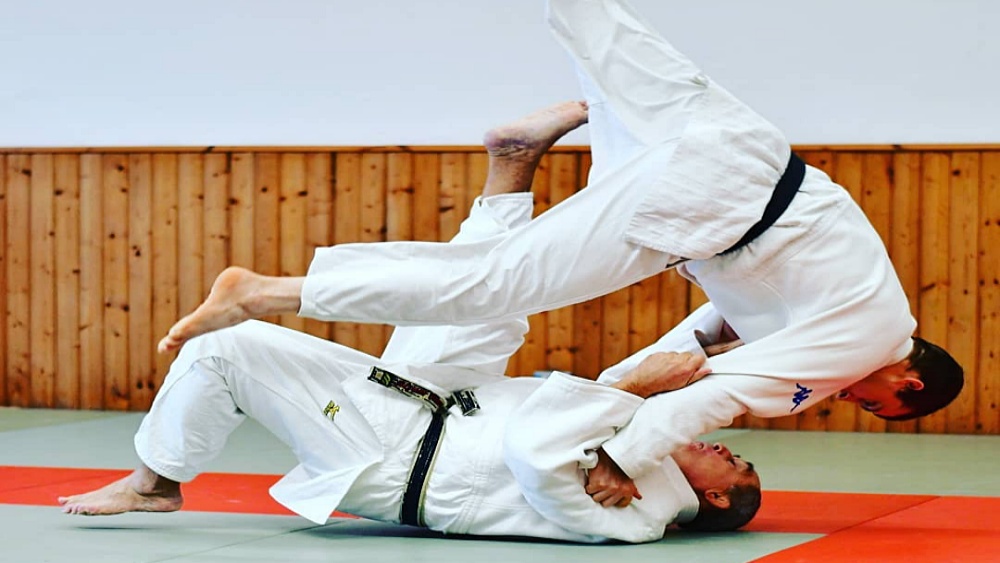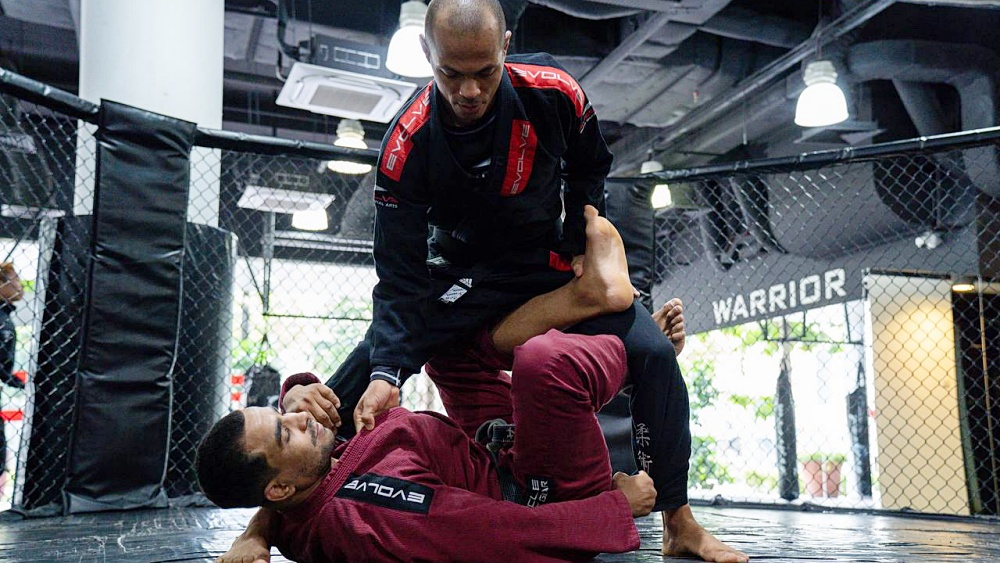One of the most satisfying yet straightforward throws you can do in grappling is the classic tomoe nage, a technique that embodies the philosophical essence of Judo – the art of using an opponent’s strength against them. The tomoe nage has established itself as one of the most important standing throws in BJJ and Judo, as it is easy to do (at least in theory) but requires a deep technical understanding to pull off against strong opponents. In this article, we’ll discuss the concept, history, and application of the Tomoe Nage.
What Is The Tomoe Nage?
The tomoe nage, or the “circular throw,” is classified under the “Sutemi Waza” category, which encompasses sacrifice techniques. In these moves, the performer deliberately places themselves in a potentially vulnerable position, often on their back, to execute a powerful throw. The term ‘tomoe nage’ comes from the Japanese ‘tomoe’, a circular shape, and ‘nage’, meaning throw, hinting at the fluidity required in its execution.
The historical roots of the tomoe nage can be traced back to the inception of Judo in the late 19th century. Jigoro Kano, the founder of Judo, incorporated it into his Kodokan Judo as he devised a martial art system that blended the practical techniques of traditional Japanese jujitsu with a philosophical approach favoring minimal effort for maximum efficiency.
How To Do The Tomoe Nage
In application, the tomoe nage can be described as a misdirection throw. The throw starts by pulling the opponent forward, disrupting their balance, and drawing them closer. At the right moment, drop down while placing a frame (usually one foot) on the opponent’s lower abdomen or hip. Doing this motion will force the opponent to roll forwards with little defense. A good tomoe nage requires a deep understanding of timing and balance. If poorly timed, the throw can leave you vulnerable to counterattacks like guard passes. This means you should be absolutely confident in your execution if you wish to use this in highly stressful environments like tournaments.
There are several variations of the tomoe nage you can do. Some examples include the yoko tomoe nage (side circle throw variation) and ma-sutemi-waza (rear sacrifice technique variation). These techniques are only different in terms of how you execute the throw, but the fundamental concept of “sacrificing” your position stays intact.
In this video, Shintaro Higashi demonstrates how to safely execute the tomoe nage. This excellent introductory video is recommended for newbies to the sport. He starts by saying that for the uke, doing a right forward step is crucial as it prepares the body to be thrown. Now for the actual technique, start by grabbing a double lapel grip. Squat down, and place your leg on your training partner‘s hip as you fall on your back. As you do this, remember to allow your partner to do a right forward step so that they can roll over safely. From here, push them over using your leg as you release your grip to finish the throw. Note that this is a drill for beginners, meaning you need to modify your approach when executing the throw in live sparring. Nevertheless, we encourage you to start with this variation and build your knowledge from here.
Three Tomoe Nages You Must Know
This video is not a super in-depth instructional, but rather an overview of some of the most common tomoe nage variations out there. The first technique Shintaro teaches is the straight back tomoe nage. From a right to right stance, all you need to do is to sit down, pull yourself under and throw them over using a leg frame, similar to the previous video. This is the most common variant of the tomoe nage. The following technique is the yoko tomoe nage where you fall to the side of your sleeve grip. Step to the side of the sleeve grip as you push and rotate their hand underneath and attack the far hip. The last technique is also a yoko tomoe nage, but now we go to the non-sleeve hand. From the starting position, where you grab the collar and sleeve, pull them forward as you put your right leg near their belt line, fall to the side, and roll them over for the finish.
Practice Makes Permanent
It’s worth noting that the tomoe nage, like all techniques in BJJ, should be learned under the guidance of a skilled instructor. This ensures proper technique is applied every step of the way. Also, understand that this technique needs to be drilled consistently. As mentioned earlier, it may seem simple enough, but it actually has a lot of moving parts. A poorly executed tomoe nage can cost you the match, so please practice the movements until you master them. It is a smart idea to drill your grip entries first, as you cannot do the throw if you don’t have the proper grips. Add more resistance to your training from here, and you should be good to go.
If you are a guard player, you can use this technique to force your opponent to drop down as you fall back to guard. It may seem counterintuitive at first, but threatening the sacrifice throw can definitely place them on the defensive, allowing you to go to your favored positions.
While the tomoe nage can be applied in No-Gi situations, using it with the Gi on maximizes its potential exponentially. Having more options to control the opponent by grabbing the collar and sleeve makes it much harder to defend against such techniques.
Conclusion
The tomoe nage is one of the best examples of turning defense into offense by using an opponent’s power against them. This centuries-old technique demonstrates how, in martial arts and perhaps life, understanding and manipulating the dynamics of force can yield surprising and powerful results. Regardless of your grappling style, adding this technique can help you better understand how to attack without using strength. Try the tomoe nage today and let us know if it works for you.
You may also like:
BJJ Throws: Everything You Need To Know And 6 Throws That Work
















